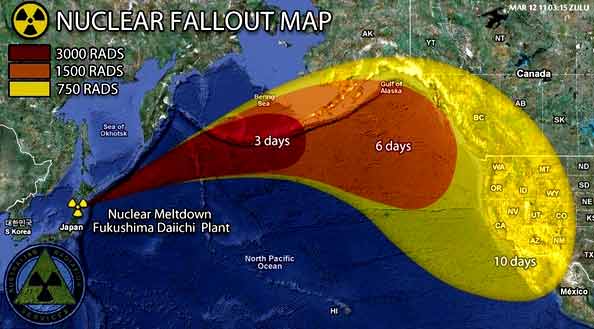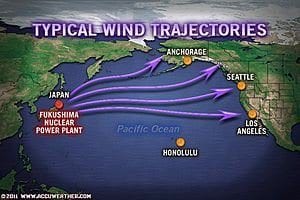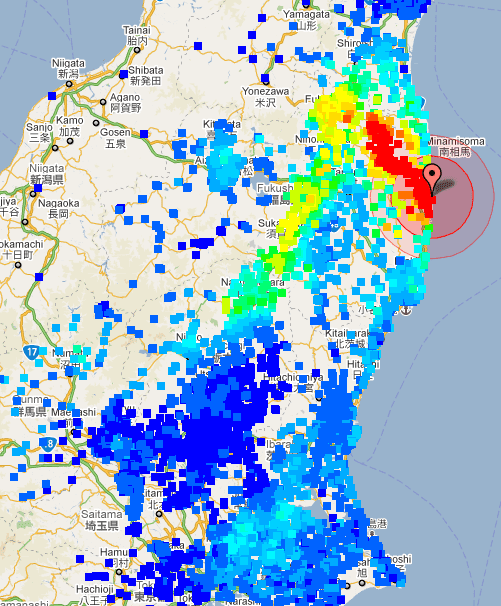Radiation affects marine life Across Pacific Ocean
While the long-term repercussions of the Fukushima Daiichi nuclear disaster are yet to be fully assessed, they are far more serious than those pertaining to the 1986 Chernobyl disaster in the Ukraine, which resulted in almost one million deaths (New Book Concludes – Chernobyl death toll: 985,000, mostly from cancer Global Research, September 10, 2010, See also Matthew Penney and Mark Selden The Severity of the Fukushima Daiichi Nuclear Disaster: Comparing Chernobyl and Fukushima, Global Research, May 25, 2011)
Moreover, while all eyes were riveted on the Fukushima Daiichi plant, news coverage both in Japan and internationally failed to fully acknowledge the impacts of a second catastrophe at TEPCO’s (Tokyo Electric Power Co Inc) Fukushima Daini nuclear power plant.
The shaky political consensus both in Japan, the U.S. and Western Europe is that the crisis at Fukushima has been contained.
The realties, however, are otherwise. Fukushima 3 was leaking unconfirmed amounts of plutonium. According to Dr. Helen Caldicott, “one millionth of a gram of plutonium, if inhaled can cause cancer”.
An opinion poll in May 2011 confirmed that more than 80 per cent of the Japanese population do not believe the government’s information regarding the nuclear crisis. (quoted in Sherwood Ross, Fukushima: Japan’s Second Nuclear Disaster, Global Research, November 10, 2011)
Worldwide Contamination
The dumping of highly radioactive water into the Pacific Ocean constitutes a potential trigger to a process of global radioactive contamination. Radioactive elements have not only been detected in the food chain in Japan, radioactive rain water has been recorded in California:
“Hazardous radioactive elements being released in the sea and air around Fukushima accumulate at each step of various food chains (for example, into algae, crustaceans, small fish, bigger fish, then humans; or soil, grass, cow’s meat and milk, then humans). Entering the body, these elements – called internal emitters – migrate to specific organs such as the thyroid, liver, bone, and brain, continuously irradiating small volumes of cells with high doses of alpha, beta and/or gamma radiation, and over many years often induce cancer”. (Helen Caldicott, Fukushima: Nuclear Apologists Play Shoot the Messenger on Radiation, The Age, April 26, 2011)
While the spread of radiation to the West Coast of North America was casually acknowledged, the early press reports (AP and Reuters) “quoting diplomatic sources” stated that only “tiny amounts of radioactive particles have arrived in California but do not pose a threat to human health.”
“According to the news agencies, the unnamed sources have access to data from a network of measuring stations run by the United Nations’ Comprehensive Test Ban Treaty Organization. …
… Greg Jaczko, chair of the U.S. Nuclear Regulatory Commission, told White House reporters on Thursday (March 17) that his experts “don’t see any concern from radiation levels that could be harmful here in the United States or any of the U.S. territories”.
The spread of radiation. March 2011
Public Health Disaster. Economic Impacts
What prevails is a well organized camouflage. The public health disaster in Japan, the contamination of water, agricultural land and the food chain, not to mention the broader economic and social implications, have neither been fully acknowledged nor addressed in a comprehensive and meaningful fashion by the Japanese authorities.
Japan as a nation state has been destroyed. Its landmass and territorial waters are contaminated. Part of the country is uninhabitable. High levels of radiation have been recorded in the Tokyo metropolitan area, which has a population of 39 million (2010) (more than the population of Canada, circa 34 million (2010)) There are indications that the food chain is contaminated throughout Japan:
Radioactive cesium exceeding the legal limit was detected in tea made in a factory in Shizuoka City, more than 300 kilometers away from the Fukushima Daiichi nuclear power plant. Shizuoka Prefecture is one of the most famous tea producing areas in Japan.
A tea distributor in Tokyo reported to the prefecture that it detected high levels of radioactivity in the tea shipped from the city. The prefecture ordered the factory to refrain from shipping out the product. After the accident at the Fukushima nuclear power plant, radioactive contamination of tea leaves and processed tea has been found over a wide area around Tokyo. (See 5 More Companies Detect Radiation In Their Tea Above Legal Limits Over 300 KM From Fukushima, June 15, 2011)
Japan’s industrial and manufacturing base is prostrate. Japan is no longer a leading industrial power. The country’s exports have plummeted. The Tokyo government has announced its first trade deficit since 1980.
While the business media has narrowly centered on the impacts of power outages and energy shortages on the pace of productive activity, the broader issue pertaining to the outright radioactive contamination of the country’s infrastructure and industrial base is a “scientific taboo” (i.e the radiation of industrial plants, machinery and equipment, buildings, roads, etc). A report released in January 2012 points to the nuclear contamination of building materials used in the construction industry, in cluding roads and residential buildings throughout Japan.(See FUKUSHIMA: Radioactive Houses and Roads in Japan. Radioactive Building Materials Sold to over 200 Construction Companies, January 2012)
A “coverup report” by the Ministry of Economy, Trade and Industry (May 2011), entitled “Economic Impact of the Great East Japan Earthquake and Current Status of Recovery“ presents “Economic Recovery” as a fait accompli. It also brushes aside the issue of radiation. The impacts of nuclear radiation on the work force and the country’s industrial base are not mentioned. The report states that the distance between Tokyo -Fukushima Dai-ichi is of the order of 230 km (about 144 miles) and that the levels of radiation in Tokyo are lower than in Hong Kong and New York City.(Ministry of Economy, Trade and Industry, Impact of the Great East Japan Earthquake and Current Status of Recovery, p.15). This statement is made without corroborating evidence and in overt contradiction with independent radiation readings in Tokyo (se map below). In recent developments, Sohgo Security Services Co. is launching a lucrative “radiation measurement service targeting households in Tokyo and four surrounding prefectures”.
“A map of citizens’ measured radiation levels shows radioactivity is distributed in a complex pattern reflecting the mountainous terrain and the shifting winds across a broad area of Japan north of Tokyo which is in the center of the of bottom of the map.”
SOURCE: Science Magazine
“Radiation limits begin to be exceeded at just above 0.1 microsieverts/ hour blue. Red is about fifty times the civilian radiation limit at 5.0 microsieverts/hour. Because children are much more sensitive than adults, these results are a great concern for parents of young children in potentially affected areas.”
The fundamental question is whether the vast array of industrial goods and components “Made in Japan” — including hi tech components, machinery, electronics, motor vehicles, etc — and exported Worldwide are contaminated? Were this to be the case, the entire East and Southeast Asian industrial base –which depends heavily on Japanese components and industrial technology– would be affected. The potential impacts on international trade would be farreaching. In this regard, in January, Russian officials confiscated irradiated Japanese automobiles and autoparts in the port of Vladivostok for sale in the Russian Federation. Needless to say, incidents of this nature in a global competitive environment, could lead to the demise of the Japanese automobile industry which is already in crisis.
While most of the automotive industry is in central Japan, Nissan’s engine factory in Iwaki city is 42 km from the Fukushima Daiichi plant. Is the Nissan work force affected? Is the engine plant contaminated? The plant is within about 10 to 20 km of the government’s “evacuation zone” from which some 200,000 people were evacuated (see map below).
Dana Durnford details much of the marine life damage from Fukushima:
Nuclear Energy and Nuclear War
 The crisis in Japan has also brought into the open the unspoken relationship between nuclear energy and nuclear war.
The crisis in Japan has also brought into the open the unspoken relationship between nuclear energy and nuclear war.
Nuclear energy is not a civilian economic activity. It is an appendage of the nuclear weapons industry which is controlled by the so-called defense contractors. The powerful corporate interests behind nuclear energy and nuclear weapons overlap.
In Japan at the height of the disaster, “the nuclear industry and government agencies [were] scrambling to prevent the discovery of atomic-bomb research facilities hidden inside Japan’s civilian nuclear power plants”.1 (See Yoichi Shimatsu, Secret Weapons Program Inside Fukushima Nuclear Plant? Global Research, April 12, 2011)
It should be noted that the complacency of both the media and the governments to the hazards of nuclear radiation pertains to the nuclear energy industry as well as to to use of nuclear weapons. In both cases, the devastating health impacts of nuclear radiation are casually denied. Tactical nuclear weapons with an explosive capacity of up to six times a Hiroshima bomb are labelled by the Pentagon as “safe for the surrounding civilian population”.
No concern has been expressed at the political level as to the likely consequences of a US-NATO-Israel attack on Iran, using “safe for civilians” tactical nuclear weapons against a non-nuclear state.
Such an action would result in “the unthinkable”: a nuclear holocaust over a large part of the Middle East and Central Asia. A nuclear nightmare, however, would occur even if nuclear weapons were not used. The bombing of Iran’s nuclear facilities using conventional weapons would contribute to unleashing another Fukushima type disaster with extensive radioactive fallout. (For further details See Michel Chossudovsky, Towards a World War III Scenario, The Dangers of Nuclear War, Global Research, Montreal, 2011)
The Online Interactive I-Book Reader on Fukushima: A Nuclear War without a War
In view of the official cover-up and media disinformation campaign, the contents of the articles and video reports in this Online Interactive Reader have not trickled down to to the broader public. (See Table of contents below)
This Online Interactive Reader on Fukushima contains a combination of analytical and scientific articles, video reports as well as shorter news reports and corroborating data.
Part I focusses on The Fukushima Nuclear Disaster: How it Happened? Part II pertains to The Devastating Health and Social Impacts in Japan. Part III centers on the “Hidden Nuclear Catastrophe”, namely the cover-up by the Japanese government and the corporate media. Part IV focusses on the issue of Worlwide Nuclear Radiation and Part V reviews the Implications of the Fukushima disaster for the Global Nuclear Energy Industry.
In the face of ceaseless media disinformation, this Global Research Online I-Book on the dangers of global nuclear radiation is intended to break the media vacuum and raise public awareness, while also pointing to the complicity of the governments, the media and the nuclear industry.
We call upon our readers to spread the word. We invite university, college and high school teachers to make this Interactive Reader on Fukushima available to their students.
References:
- www.threemileisland.org/science/what_went_wrong/index.html www.defense-update.com/products/m/magna.htm www.jimstonefreelance.com/turbine.jpg
- www.telegraph.co.uk/technology/news/8326274/Israeli-security-chief-celebrates-Stuxnet-cyberattack.html
- www.english.pravda.ru/history/22-02-2011/116985-Israeli_general_boasts_authoring_Stuxnet-0/
- www.telegraph.co.uk/news/worldnews/middleeast/israel/8326387/Israel-video-shows-Stuxnet-as-oneof-its-successes.html www.reports.internic.net/cgi/whois?whois_nic=magnabsp.com&type=domain
- www.magnabsp.com www.jpost.com/Defense/Article.aspx?id=212168
- www.infosecisland.com/blogview/12628-Japans-Nuclear-Crisis-Stuxnet-and-SCADA-Defenses.html
- www.yomiuri.co.jp/dy/national/T101004003493.htm www.jimstonefreelance.com/door.jpg
- www.jimstonefreelance.com/borated.jpg www.news.discovery.com/earth/2011/03/12/fukushima-zoom.jpg
- www.nytimes.com/cwire/2011/03/25/25climatewire-us-experts-blame-fukushima-1-explosions-and- 19903.html?amp=&pagewanted=all www.jimstonefreelance.com/reference.jpg
- www.jimstonefreelance.com/containment.jpg www.jimstonefreelance.com/reactorlid.jpg
- www.pcworld.com/article/224811/fukushima_daiichi_workers_clear_debris_by_remote_control.html
- www.jimstonefreelance.com/03.pdf www.jimstonefreelance.com/core.jpg
- www.jimstonefreelance.com/camera.jpg www.rense.com/general93/hid.htm
- www.pinktentacle.com/2011/04/high-resolution-photos-of-fukushima-daiichi/ (source of high resolution photos)
- Fukushima: A Nuclear War without a War (by Michel Chossudovsky)
Additional Resources:
- VIDEO: Fukushima’s 10th Anniversary (Corbett Report)
- Fukushima: The Speech that Let the Cat out of the Bag
- Leuren Moret: USA, UK Monarchy behind Fukushima radiation genocide
 The Tōhoku earthquake struck just before three on a Friday afternoon. Massive earthquake damage was followed by tsunami rising to heights of 40 meters that swept 10km inland, scouring the land of homes, school, communities, and people. The earthquake and tsunami alone were disasters of incredible proportion, resulting in over 15,000 deaths, over 100, 000 buildings destroyed, and economic losses estimated as high as $235 billion by the World Bank.
The Tōhoku earthquake struck just before three on a Friday afternoon. Massive earthquake damage was followed by tsunami rising to heights of 40 meters that swept 10km inland, scouring the land of homes, school, communities, and people. The earthquake and tsunami alone were disasters of incredible proportion, resulting in over 15,000 deaths, over 100, 000 buildings destroyed, and economic losses estimated as high as $235 billion by the World Bank.
And that was only the natural disaster.
The manmade disaster began the same day, as the tsunami swept over the seawall of the Fukushima Daiichi Nuclear Power Plant, flooding the facility and destroying much of its equipment, including its onsite emergency power generators. Cut off from all external power sources, the reactors and spent fuel-rod assemblies began to overheat.
Three reactors suffered meltdowns. Hydrogen gas explosions blew apart the outer containment buildings on three reactors. And the world watched as Japan struggled to bring the situation under control before the worst scenario came to pass.
Despite further natural and manmade obstacles, the men and women at the plant succeeded in their efforts, gradually bringing the reactors under control, restoring power, and edging back, one inch at a time, from the very brink of disaster.
This is their story, based on extensive interviews with the people who fought and won that battle, and especially with Masao Yoshida, the man who drove them all to get the job done.
Here at last is the inside story of what they faced, what resources and information they had to work with, and why they made the decisions they did.
 Whether this is your first book on nuclear power, or your twentieth, you will still find the history to be astounding and surprising. The impact of radiophobia and the history of radiation is not dull but fascinating. Extremely well-researched, no other book delves so deeply into how we react to radiation and nuclear power. There is a special fear around nuclear things, and this extends to nuclear power as well as nuclear weapons. This was a new kind fear, not similar to previous responses to new technology. It is profound, disquieting and all encompassing. By the time of Atoms for Peace, anxiety about nuclear weapons had shaped a long-lasting legacy that would taint views of nuclear power for decades. The dominant response to nuclear is avoidance. Coverage of nuclear power has been dominated by the threat of accidents or any kind of incident that occurred at nuclear power plants. This negative attention about accidents and their potential impact would interfere with the integration of nuclear power into modern society. Accidents seemed limitless in their potential damage, and the lack of public knowledge about their impact allowed imaginations to run wild. The crux of the pro-nuclear and anti-nuclear debate rests on the estimations about the significance of potential accidents. Were they capable of massive destruction and tremendous risk or was their impact compact, limited and minor? The scale of a ‘worst-case scenario’ became the key question of the nuclear power debate, and proved to be quite powerful in affecting its history. Chernobyl, Fukushima, and even Three Mile Island became larger-than-life incidents and each acquired their own mythology. The perceptions of what happened set the tone for attitudes about nuclear power. Despite being an essential part of the natural environment, radiation is rarely well understood. We are exposed to radiation everyday from the earth below and the sun above, yet parents believe it is more important for children to learn about volcanoes than radiation. The fear of nuclear power and radiation has become significant in itself, changing the course of history. Nuclear power has been decisively shaped by political struggles and emotional arguments that even affected its technological development. Negative feelings about nuclear power contrast with the benign feelings towards wind and solar, so considerable resources and subsidies are devoted to them, in the hope these can make a meaningful impact to reduce emissions. A strong consensus supports wind and solar in contrast to the divisive debate around nuclear power. The emotional responses are driving our attitudes to technology and energy, which does not always result in the most logical ends. The history of nuclear power is both revelatory and surprising, and it will definitely change the way you think about energy in the modern world. (This paperback format was specifically designed to be easy to read)
Whether this is your first book on nuclear power, or your twentieth, you will still find the history to be astounding and surprising. The impact of radiophobia and the history of radiation is not dull but fascinating. Extremely well-researched, no other book delves so deeply into how we react to radiation and nuclear power. There is a special fear around nuclear things, and this extends to nuclear power as well as nuclear weapons. This was a new kind fear, not similar to previous responses to new technology. It is profound, disquieting and all encompassing. By the time of Atoms for Peace, anxiety about nuclear weapons had shaped a long-lasting legacy that would taint views of nuclear power for decades. The dominant response to nuclear is avoidance. Coverage of nuclear power has been dominated by the threat of accidents or any kind of incident that occurred at nuclear power plants. This negative attention about accidents and their potential impact would interfere with the integration of nuclear power into modern society. Accidents seemed limitless in their potential damage, and the lack of public knowledge about their impact allowed imaginations to run wild. The crux of the pro-nuclear and anti-nuclear debate rests on the estimations about the significance of potential accidents. Were they capable of massive destruction and tremendous risk or was their impact compact, limited and minor? The scale of a ‘worst-case scenario’ became the key question of the nuclear power debate, and proved to be quite powerful in affecting its history. Chernobyl, Fukushima, and even Three Mile Island became larger-than-life incidents and each acquired their own mythology. The perceptions of what happened set the tone for attitudes about nuclear power. Despite being an essential part of the natural environment, radiation is rarely well understood. We are exposed to radiation everyday from the earth below and the sun above, yet parents believe it is more important for children to learn about volcanoes than radiation. The fear of nuclear power and radiation has become significant in itself, changing the course of history. Nuclear power has been decisively shaped by political struggles and emotional arguments that even affected its technological development. Negative feelings about nuclear power contrast with the benign feelings towards wind and solar, so considerable resources and subsidies are devoted to them, in the hope these can make a meaningful impact to reduce emissions. A strong consensus supports wind and solar in contrast to the divisive debate around nuclear power. The emotional responses are driving our attitudes to technology and energy, which does not always result in the most logical ends. The history of nuclear power is both revelatory and surprising, and it will definitely change the way you think about energy in the modern world. (This paperback format was specifically designed to be easy to read)
 The story begins in Alaska near the HAARP Complex, one of five previously existing locations refitted as doomsday shelters in case of a Rapid Climate Changing event. Big Thunder was that event. Around mid-century a long overdue earthquake at the northern periphery of the Mid-Atlantic-Ridge caused half of the pockmarked ice-sheet to cascade off Greenland and the following tsunami crashed global civilization. Two weeks later due to pressure being released on the island, the landmass jutted upwards releasing methane hydrates and other greenhouse gases, jettisoning most of the remaining ice. As a result, the thermal oceans currents shut down completely, creating the mid-latitude badlands and ushered in a paleolithic atmospheric/hydrological pattern. After fighting their way north through the Badlands, Abram and the J-Squad rescue four lady scientists under fire from cannibalistic marauders. These scientists, who run the HAARP Complex, are tasked with assisting any survivors in rebuilding civilization. In their gratitude they invite the J-Squad to take up residence at the compound. What follows is an adventure from combating marauders to starting a sustainable culture; the HAARP Letters deals with personal, civil and interpersonal dichotomies. A few issues this mismatched group confronts are the creation of an educational-based merit system, a disputed new religion, Doni Forever, based on Earth First principles, and the same old vices of greed and power lust, that have plagued mankind as once again these arise as civilization begins it journey toward a new purpose on Mother Earth.
The story begins in Alaska near the HAARP Complex, one of five previously existing locations refitted as doomsday shelters in case of a Rapid Climate Changing event. Big Thunder was that event. Around mid-century a long overdue earthquake at the northern periphery of the Mid-Atlantic-Ridge caused half of the pockmarked ice-sheet to cascade off Greenland and the following tsunami crashed global civilization. Two weeks later due to pressure being released on the island, the landmass jutted upwards releasing methane hydrates and other greenhouse gases, jettisoning most of the remaining ice. As a result, the thermal oceans currents shut down completely, creating the mid-latitude badlands and ushered in a paleolithic atmospheric/hydrological pattern. After fighting their way north through the Badlands, Abram and the J-Squad rescue four lady scientists under fire from cannibalistic marauders. These scientists, who run the HAARP Complex, are tasked with assisting any survivors in rebuilding civilization. In their gratitude they invite the J-Squad to take up residence at the compound. What follows is an adventure from combating marauders to starting a sustainable culture; the HAARP Letters deals with personal, civil and interpersonal dichotomies. A few issues this mismatched group confronts are the creation of an educational-based merit system, a disputed new religion, Doni Forever, based on Earth First principles, and the same old vices of greed and power lust, that have plagued mankind as once again these arise as civilization begins it journey toward a new purpose on Mother Earth.






